Saskatoon, Saskatchewan.

During our 3 night stay at Saskatoon we visited the Western Development Museum Boomtown Years 1910. An older man started walking with us and started telling about his early years in this area. We found out that SANDY is 86 and has been volunteering at the museum 2 days a week as a living "MEMORY BANK" since 1978! He told us that the name Peter/Peters (Ruth's maiden name) was common during that period of time as Saskatchewan was being developed. Settlement was rapid in the late 1890's and early 1900's. Agricultural development gained strength after farmers began to plant a type of wheat that thrived in Saskatchewan's short growing season.

New settlers established homesteads in record numbers. From 1901 to 1911, the population increased from 91,279 to 492,432. Good free land and rising wheat prices attracted many immigrants from Scandinavia and Central and Eastern Europe. Rapid population growth spurred the building of railroads, towns, and cities.
Saskatchewan became a province of Canada in 1905. But the federal government kept control of Saskatchewan's public lands and natural resources, including its forests and mineral deposits, until 1930.
Petroleum is Saskatchewan's most important mined product. The province has four major petroleum-producing regions: Estevan-Weyburn in the southeast; Swift Current and Kindersley, both in the southwest; and Lloydminster in the west-central part of Saskatchewan. About 60 percent of the petroleum mined in Saskatchewan is exported to the United States. Much of the remainder of Saskatchewan's production is sold in Canada's eastern provinces.
Saskatchewan is North America's leading producer of potash. Saskatchewan's potash mines are located in the southern third of the province.
We finished our visit with a coffee at the authentic Boomtown Cafe
After buying some Saskatoon Berry pie and some perogies we left for Alberta. Vast sections of Saskatchewan were pioneered by Ukrainians and Russians.



0 Comments:
Post a Comment
<< Home